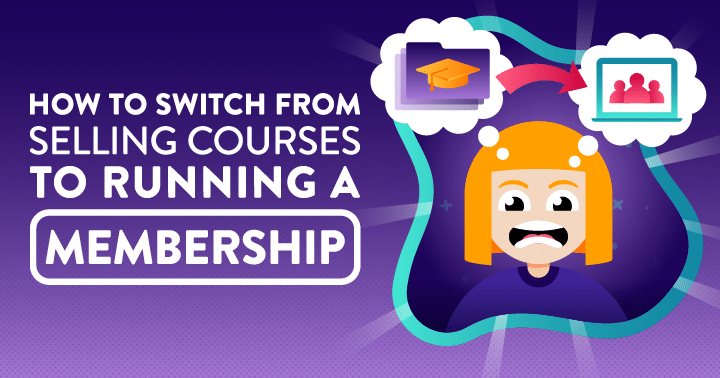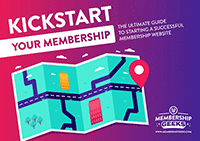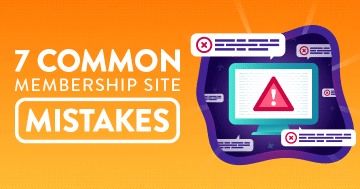Have you been thinking about transitioning your one-off online courses to selling subscriptions to a membership website?
This decision is a big one and I can’t emphasize that enough.
It could turn out to be the best decision you ever made OR a complete error in judgement. It just depends on a variety of factors that you need to seriously consider before taking this step.
As Benjamin Franklin said, “By failing to prepare, you are preparing to fail”.
So, I encourage you to read on and give some thought to the points I mention before you make the switch.
1) There will be a big change to your revenue model
Typically, the launch cycle for an online course requires short bursts of intense marketing and promotion several times a year.
The cycle begins with the opening of your course, some ongoing marketing and promotion for a limited time, closing the doors to enrollment, and allowing your students to go through their learning journey on their own.
After some time, you ramp up the marketing efforts again, and you rinse and repeat.
This launch cycle is unique to online courses. And the benefit?
After each launch, you can expect the income to come pouring into your bank account in one large, lump sum until the next time you decide to offer your program.
You become dependent on these large cash injections in the short term.
But…
The risk of an unsuccessful launch can cripple your business in the short term.
The peak and valley cycle of successful and failed launches leaves your bank account and your business vulnerable!
There are several reasons why your launch can fail.
Perhaps the timing wasn’t right for your students or your key affiliates just couldn’t make it work this time around.
In the long term, these peaks and valleys are not desirable as you have no reliable way of forecasting your income and planning for your future.
When considering offering a membership program to your audience, the revenue model will change drastically.
With a subscription model, your income now becomes more consistent and predictable because it is recurring monthly.
You will no longer be able to depend on large injections of cash at various times of the year.
But you will have smaller amounts of ongoing monthly revenue that will accumulate and build slowly over time.
This will take some getting used to!
In the initial stages of this transition, income will trickle in while you are just starting to pick up momentum with your membership site.
When you’re initially launching your membership for the first time, then a kick-off or launch event is the right way to go.
With a large influx of new members, it can make the transition into this revenue model a little bit easier. Some people apply the ongoing launch cycle for membership sites as well.
But in most cases, you are now getting the worst of both worlds.
You are locking yourself into the peak and valley model but WITHOUT the huge amounts of cash inflow that come from selling a $2000 course, for example.
With the lower monthly subscription price as compared to the cost of a course, the cash inflow is just not enough to justify the open and close nature of the launch cycle.
There are lots of negative effects of using a closed-door strategy for a membership site that I cover elsewhere.
Realistically, for long term membership, you want to keep your website steadily open to new subscribers.
2) It will affect your existing course members
You will need to think about how you will handle the transition for your existing course members/students.
Having this community already established is a huge advantage and can have a positive effect on building momentum and excitement around your new membership site.
What you need to consider at this stage is if your students will join for free or if they will pay the subscription.
Ask yourself this question: Does your membership offering cover the same material as your courses?
If yes, then you most likely will allow your students to join for free or at an extremely low price.
Your students are savvy enough not to waste their money on resources they’ve already purchased from you.
And they won’t forget if they realize you are charging them twice for the same material.
This could be harmful to your reputation.
But, if you plan to go above and beyond what you offered in your course with more material and practical resources in your membership site, then you should consider offering them a preferred or special rate.
You are effectively grandfathering in your existing course customers at a special rate as a ‘Thank You; but also as an incidental apology for making them switch from one platform to another.
What they have already bought and paid for will affect the pricing you decide to offer.
Another scenario to consider is when students choose not to sign-up. You will need to have a plan in place for this situation as well.
How will they part ways with you while still getting what they paid for?
The worst possible outcome is for you to continue to maintain two separate websites: one for your membership and one for your course customers who have chosen not to make the switch.
This has headache written all over it.
You want to make sure your customers leave you on the best of terms. They should walk away with all the course materials they paid for. Make sure that all your course materials (videos, workbooks etc.) are available to them to download and keep.
Your end-goal is to remove the platform that your course customers logged into.
3) It will change your marketing methods
The nature of these two different approaches to sharing your expertise have contrasting marketing methods.
While the online courses need intense marketing and promotions at kick off up to the close date, with a rinse and repeat pattern throughout the year, the membership model requires ongoing marketing as the option to subscribe is always open year-round.
Believe me. We have tried and tested the options. And in our view, remaining open year-round makes a lot more sense on all fronts in the majority of cases.
Your marketing activities will revolve around consistent lead flow that is generated through ongoing content marketing activities that will attract, engage, and nurture your potential subscribers all year round.
So, the question becomes, where are your strengths?
If you feel most comfortable using things like scarcity tactics, or you rely heavily on affiliates and partners, and you are good at concentrating your marketing efforts in short bursts, then you are probably more suited to the course model with a launch cycle.
And the marketing style of the membership model would be a big adjustment and may not be the best fit for you.
4) It will require onboarding, engaging and retaining your community
When you are selling one-off courses and a purchase has been made, your job is essentially done. You have made it to the finish line.
When you are running a membership site and a subscription is paid for, the race has just begun!

You now have to make sure that they are properly onboarded, they are assimilated into your membership community and you are keeping them engaged month after month.
All your efforts need to stay focused on onboarding, member engagement and retention.
And this requires a very different skillset than selling one-off courses.
You will need solid strategies to make sure each of these stages in the subscriber journey are being supported for as long as you maintain the membership site.
If you’re not retaining, then you lose out on that recurring revenue.
You need to be prepared for this when switching from selling one-off courses to running a successful membership site.
Remember: A membership website is not for everyone!
Perhaps your skill set, knowledge and experience has provided you with a very successful course offering with glowing student reviews.
It may be wise to stick with what you’re good at and continue down that path.
Switching from a course to a membership site isn’t just a case of semantics, or making a few tweaks and rejigging a few things.
It is a MAJOR mindset shift.
Hopefully we provided you with great information to support you in your decision-making process.
Take some time and give some thought to whether or not making the switch is right for you.





